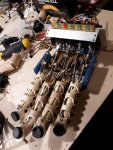Gramps
Senior Member
This robot hand has been gathering dust on the shelf for many years.
It still needs a thumb but controlling the digits is the problem we're addressing now.
The servos were converted to continuous rotation.
We removed the pots that were inside the servos and added 5K slider pots that are positioned under the threaded rods that move the digits.
We hoped that as the digit moved, we could get the slider pots to move in unison, but it's erratic.
Using bendable variable resistors on the back of the fingers might work, but they're pricey.
Perhaps a 5 K resistor across a limit switch at each end?
Any other suggestions?
Thanks, Gramps
It still needs a thumb but controlling the digits is the problem we're addressing now.
The servos were converted to continuous rotation.
We removed the pots that were inside the servos and added 5K slider pots that are positioned under the threaded rods that move the digits.
We hoped that as the digit moved, we could get the slider pots to move in unison, but it's erratic.
Using bendable variable resistors on the back of the fingers might work, but they're pricey.
Perhaps a 5 K resistor across a limit switch at each end?
Any other suggestions?
Thanks, Gramps
Attachments
-
959.6 KB Views: 25


 Shaft encoders. Good idea!
Shaft encoders. Good idea!